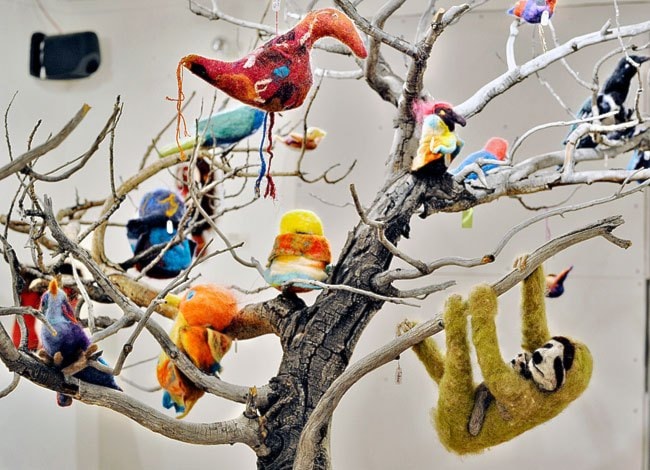Various things inspire Mary Beattie’s art: the sunlight that flows into her home on Shallow Bay, trap lines, books about the history of cod fishing. But regardless of the source, felting consistently produces a common reaction: peace.
“It’s a very peaceful thing, until you stick yourself with the needle!” she laughs, when asked what she likes about this art form. “So, you have to focus.”
Beattie is the main organizer of How Does it Felt. The exhibit at Arts Underground features work from seven different female textile artists from around the territory. Along with Beattie’s work, there are pieces by Shiela Alexandrovich, Jeanine Baker, Louise Hardy, Ann MacKenzie, Susan Stuart and Kate Williams. The show took about a year to put together, said Beattie.
Felting is a form of fibre art. Artists start by making wispy layers of wool, then layering them on other pieces of fabric. They poke the fabric with barbed needles to create patterns and textures.
In wet felting, hot, soapy water is poured over the piles of fibres. Cold water is then poured on top, and the combination of heat, cold and soap creates the felt.
In some respects, felting is a lot like painting, said Beattie. Overlapping colours create depth, and the background always needs to be done before the foreground, she said.
But she finds it easier to show control when felting, she said. The pieces on display show the many ways the art form can be used. Besides pictures of landscapes, the exhibit showcases items like gloves, hats, sashes, belts, girdles and wool balls sitting in wool bowls.
A picture of the Peel watershed covers a wool jacket. A dragon marionette is also included. And there’s one collaborative piece, The Singing Tree, in which felt birds are perched on a poplar tree that Beattie brought from a rock outcropping near Lake Laberge.
Nature provides much of Beattie’s inspiration, and materials. Birchwood from around Lake Laberge frames much of her landscapes. When she first began felting in the early 1990s, she made wool from the hair of the dogs she ran on her traplines. Now, she purchases all her wool.
[image2]
She likes to capture the mood of a place. She felts, and paints, in an impressionistic style, and jokingly calls herself “VanGoof.”
But serious themes run through some of her pieces. An Old Story was inspired by the history of cod fishing and all the people who died at sea, their graves unknown. Concerns about mining’s environmental impacts spurred Habitat, a marten she wet-felted into a burl.
It’s not the only piece with a political feel. Jeanine Baker, who learned to felt from Beattie, felted a picture of the Peel watershed on a swandri wool jacket she bought in New Zealand. There’s a lot of history to the piece of clothing, she said.
Farmers in New Zealand used to wear the jackets. She wore it, and steel-toed boots, when she married at Crag Lake. But the jacket was just lying around her house. “I wanted it to be worthwhile,” she said. She had been thinking about the Peel watershed. She spent about 60 hours felting those thoughts onto the jacket, she said.
Some of the pieces on display cover more imaginative subjects. Susan Stuart enjoys needle felting because it allows for great details. “It’s like sculpting with wool,” she said.
Her nine pieces include one inspired by her fondness for dragons, she said. She lives in Mayo, and when she makes the four-and-a-half hour drive to Whitehorse, she often listens to audiobooks. Her creations were inspired by listening to J.R.R. Tolkien’s The Hobbit, and by her interest in the Loch Ness monster of Scotland. While a marionette wasn’t her original idea, she thought it might be fun to make a dragon “that could kind of run, and maybe flap its wings somehow and looks really scary.”
She may still work on her original dragon concept, she said.
Regardless of the inspiration, felting can help create community. Baker and Beattie often felt on moose-hunting trips with their husbands, said Baker.
“I love to share it,” said Beattie, who teaches felting classes at Arts Underground to students from the Independent Learning Centre and at festivals in Mayo and Atlin.
She’s seen it benefit people in other ways.
As she tells the kids in Mayo, it’s healthy. “It’s a really good way to stop smoking, because you have no time to smoke when you’re felting. It’s totally addictive,” she said.
You can catch the show at Arts Underground until Dec. 1.
Contact Meagan Gillmore at
mgillmore@yukon-news.com
